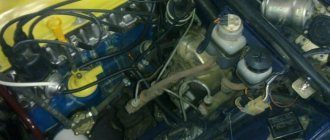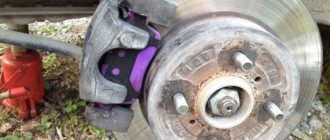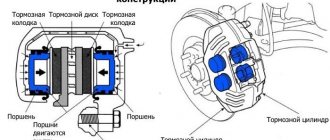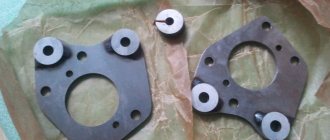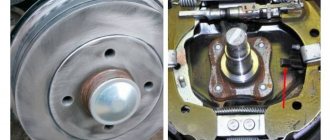AvtoVAZ's new product, the Lada Vesta, quickly burst into the Russian car market and quickly won the trust of its compatriots. Modern design and a high level of comfort significantly distinguish this car from other models of the concern, but it is not spared the fate of minor malfunctions. Among them is a breakdown of seat heating, which causes discomfort to the owner in winter. Read on to learn how to diagnose and fix this problem yourself.
Diagnostics
Consistent diagnostics of this defect will help to identify the cause of the malfunction. First of all, you should make sure that the fuse responsible for the heated seats is intact. To do this, open the fuse box located in the lower left part of the instrument panel. Find fuse F5 15A (see photo), remove it and make sure it is intact.
If it is in order, you should make sure the button is working. When the ignition is turned on, the indicator should light up. As a rule, buttons very rarely fail, so if the indicator lights up, move on.
For the next step, you will need a multimeter and the ability to handle it. Almost all such devices have a function for testing electrical circuits. Now you need to get to the plugs that connect the car's wiring and the connectors on the bottom of the seat.
To facilitate access to the connections, it is recommended to unscrew the seat and tilt it in the desired direction.
After disconnecting the plug, you need to make sure that power is supplied to the car wiring wire when you press the button. Then “ring” the connector on the seat if the heating element of the whole device makes a characteristic sound.
Clutch problem
However, you can try to determine whether the whistling sound when driving the car is actually due to this problem. To do this you need:
- Place the car on a small hill. This will create force when starting off. This way you can put more load on the motor when starting to move, which will allow you to hear the whistle better.
- Now you need to engage first gear and move off by slowly pressing the gas pedal. This way you can recognize the moment when the car starts to whistle.
- If there is a whistle when the car starts to move, that is, while the clutch is grasping, then this indicates a malfunction. To be sure, it is necessary to conduct several more similar tests. If in doubt, you can try to move off from second gear. This will increase the load on the clutch, and the whistle will be heard more clearly.
It is unrealistic to hear such a sound emanating from a node at speed. Therefore, if the whistle is clearly visible when starting, but is completely absent when driving at speed, then most likely the problem is in the clutch.
Remedies
If you find a blown fuse, replace it with a new one from the spare set, or buy a similar one. But here it’s worth thinking about why the old one burned out; maybe there’s a short circuit somewhere in the circuit.
If there is no indication when turned on, you should replace the button with a new one, because this part cannot be repaired. Carefully remove the toggle switch from its seat, disconnect the plug and replace the part.
After carefully stripping the ends of the element, twist them together, first extending the soldered parts with another conductor. This could be a piece of thin copper wire. Be sure to insulate the connection to avoid fire.
If there is no power to the car wiring, the best solution is to contact a service center, since it is quite difficult to find out the reason on your own in this case.
I am often reproached for writing obvious things. Like I’m a stupid “Captain Obvious”, and everyone else has a subtle mind and are extraordinary individuals.
I’ve been used to this for a long time and, although I sometimes answer in the comments, I don’t pay attention to these attacks. By the way, if you ever decide to start a channel on Zen, then be prepared for the fact that they will throw crap at you in the comments.
Our society is sick, and there are a lot of people on the Internet who assert themselves by insulting and humiliating others. Well, people are unlucky - they got a bad grade at school or they don’t like girls. This should simply be accepted as the fact that the Earth revolves around the Sun.
Therefore, comments like “next time write that to turn right you need to turn the steering wheel clockwise” will appear under articles constantly. And this is another completely harmless example.
Anyway. The introduction took a long time. More to the point...
Although no. A little more “foreplay”.
I am also often reproached for having to read the instructions first and then get into the car. Well, yes. Certainly. Everyone kind of does that.
In fact, 99% of people just get in and drive. This is why an “intuitive interface” has been created so that any driver can sit down and drive without reading any instructions.
But modern cars, in addition to basic functions, provide many additional ones. And it is these additional features that bring surprises, as I have already written about many times.
And here's another surprise from heated seats. I already said that I went to Omsk over the weekend. It was warm in the car, but for some reason my wife was freezing. So she turned on the heated seats. As you probably know, when you press the button for the first time, one of three heating modes is turned on, and all three lights are on.
It is logical to assume that this is the most powerful mode. And indeed, in this mode the seat heats up very quickly and quite noticeably. But this is if you got into a cold car.
But in a warm car, the seat hardly heats up at all, which is what my wife complained about.
Of course, I didn’t bother to deal with this on the way. But when I returned home, I looked at the instructions. And it turned out that in this mode the seat heating works automatically and the temperature of the seats depends on the temperature in the cabin.
Automatic mode is set the first time you turn it on (see page 27 of the instructions).
I am sure that not everyone knows about this (well, at least among those who recently bought a car). So don't thank me)))
And yes - for some I am “Captain Obvious”. But only for those who were immediately born able to walk, talk and not pee in their pants. In general, Homo sapiens develops and learns throughout his life. There's no shame in not knowing something. It is a shame not to strive for knowledge.
Seat heating buttons on Lada Vesta
Main stages during dismantling and disassembly:
- We place the car on a flat platform, platform. A roadside overpass or inspection hole will not be needed.
- We provide priority safety measures, squeeze the parking brake.
- On the driver's (passenger) side, move the seat all the way back and unscrew the two screws at the base.
- Similar steps, just move it forward all the way and unscrew the two screws.
- Turn off the ignition and reset the battery terminals.
- We disconnect the contact chips from the limit switches.
- We remove the seat from its regular place and place it on a workbench for preventative maintenance.
- We dismantle the plastic decorative insert and cladding.
- Unclench the metal brackets and release the heating element.
- We remove the foam rubber.
- We carry out troubleshooting of the EPS and detect mechanical damage.
- Based on the results obtained, we decide on the advisability of replacing or restoring the previous one.
- We assemble the structure in reverse order.
Posts 1 to 25 of 42
1 Topic from Igor 2016-03-18 00:21:11 (2016-03-18 01:03:30 edited by Igor)
Topic: Engine Ringing
2 Reply from gamer 2016-03-18 05:13:18
Re: Engine clanging
At what point? 6:40, for example? I think it's some kind of tinkling video, maybe Chinese too
3 Reply from Filka_Luzer 2016-03-18 05:21:46
Re: Engine clanging
Was it ringing like that from the very beginning?
4 Reply from 89205 2016-03-18 05:47:28
Re: Engine clanging
You hear some kind of ringing when the engine is running.
Does it always ring or only in certain modes?
5 Reply from Dmitriy.Kazantsev 2016-03-18 06:15:45
Re: Engine clanging
It's ringing too! I already wrote and listened to it at the dealer. We brought two new Vestas into the salon and both whistle. It starts to whistle when warmed up and the whistle is so short-lived
6 Reply from Iznanka 2016-03-18 07:44:05
Re: Engine clanging
Maybe the belt is squealing. Didn't listen to where exactly the sound came from?
7 Reply from Igor 2016-03-18 15:54:14
Re: Engine clanging
I think the generator is ringing.
8 Reply from Igor 2016-03-18 15:57:40 (2016-03-18 16:08:46 edited by Igor)
Re: Engine clanging
At what point? 6:40, for example? In my opinion, this is some kind of video tinkling, Chinese too, maybe ac
Yes, from the very beginning it rings, something tells you to get used to this ringing(.
Yes, I started to notice it almost immediately, but not so loudly, now it rings more.
Does it always ring or only in certain modes?
Maybe the belt is squealing. Didn't listen to where exactly the sound came from?
It starts to whistle when warmed up and the whistle is so short-lived
9 Reply from Iznanka 2016-03-18 16:58:37
Re: Engine clanging
It already rings even when the engine is cold, as if the timing belt roller is jammed
Most likely the roller is ringing on the attachment belt.
10 Reply from Cd252 2016-03-18 17:52:09
Re: Engine clanging
Take a listening ear and look for the source of the sound. How does the dealer comment on this sound?
11 Reply from Hivus 2016-03-18 18:09:46
Re: Engine clanging
The rollers are Chinese, you can change everything at once.
12 Reply from Dmitriy.Kazantsev 2016-03-18 18:11:08
Re: Engine clanging
After visiting the dealer, the warranty engineer called three days later. He said that he called the factory and they know about this problem and added that the ringing is related to the design of the generator. At the end of the month I’m going back to the manager and I’ll tell him again
13 Reply from Iznanka 2016-03-19 05:29:54
Re: Engine clanging
He said that he called the factory and they know about this problem and added that the ringing is related to the design of the generator.
Generator roller or generator itself?
14 Reply from Alex222 2016-03-19 15:33:56
Re: Engine clanging
This is a semi-V belt and everything that goes with it!
There are a lot of things that can ring there, literally everything attached. Or does the belt itself somehow manage to ring?
15 Reply from Klyuv 2016-03-20 15:03:07
Re: Engine clanging
semi v-belt
16 Reply from Hedgehog 2016-03-20 15:38:29 (2016-03-20 15:39:21 edited by Hedgehog)
Re: Engine clanging
Hi all. There is no ringing, there is a whistle, it appeared as everything began to flow through the streets, I suspect that sand and dirt got in, I could not identify the specific source of the sound, the whistle came from somewhere from the belt. Is it possible to drive, what do you think?
17 Reply from Hedgehog 2016-03-21 11:55:16
Re: Engine clanging
Today I started it in the morning and it whistles all day
I think I should wash the engine? If there is dirt somewhere, it will be washed off and the sound may go away?
18 Reply from gamer 2016-03-21 14:37:39
Re: Engine clanging
It would be good to lubricate it.
19 Reply from Dmitriy.Kazantsev 2016-03-21 16:24:54
Re: Engine clanging
I have exactly the ringing. The sound is like a bolt rattling in a glass. And the bell rings two or three seconds later
20 Reply from Igor 2016-03-30 12:38:02
Re: Engine clanging
21 Reply from d.PO 2016-03-30 13:26:16
Re: Engine clanging
the load increases, the motor starts working in a different mode and speed
22 Reply from Igor 2016-03-30 14:57:44
Re: Engine clanging
Wangyu, the Conder will be what you need. )
23 Reply from peaceful atom 2016-03-30 15:35:51
Re: Engine clanging
Maybe something gets pressed up when the load increases and the sound goes away.
Where is the heating mechanism located?
In cars of the Lada Granta and Lada Vesta family, the EPS are located under the front driver and passenger seats.
To carry out preventive maintenance and diagnostics, first dismantle the seat.
Note to the driver. Before dismantling, be sure to turn off the ignition and reset the battery terminal. Since an AIRBAG unit is located under each of the seats, turning off the limit switches when the power is activated will lead to an open circuit and false alarms of the sensors.
Why doesn't the heated seats work?
There are only three reasons causing EPS malfunction:
- the seat heating fuse on the Lada Vesta has blown;
- break in the heating element circuit;
- The mechanical switch (button) has failed.
Most often, a chain break occurs due to frequent pressure on the corner of the seat with the knee.
First, determine if the fuse is working properly. It often happens that after dismantling the “seat” and disassembling it into its component elements, the cause of the breakdown was not identified.
If the fuse is faulty, the indicator on the dashboard will not light up when the engine starts. The factory fuse is marked F33, current 15A.
The fuse box is located at the bottom of the dashboard on the driver's side.
The heated driver's seat may not work due to failure of adjacent mechanisms and units. For example, electronic control unit, fuse box, battery, temperature sensor.
Detailed diagnostics: structural component of knocking
Guided only by a thermal sign, it will not be possible to find out exactly why the hydraulic compensators are knocking. An additional set of tests is required. Its essence is to analyze changes in the acoustic design of the Vesta engine, changing the speed and taking into account the temperature of the coolant.
Operating with revolutions
The testing stages boil down to analyzing the operation of the motor in various modes:
Consequences of ignoring a fault
The main prerequisite for troubleshooting is intrusive extraneous noise. Few people know what the real danger of tapping is. Excessive clearances in the timing belt affect the operating mode of the cams: the resulting shock loads significantly reduce the service life of the crankshaft.
Recommendations for repairs and selection of alternative options
Before dismantling the seat(s), carry out initial diagnostics and identify the source of the breakdown. Based on the analysis of the data obtained, calculate the number of necessary spare parts and consumables.
In order to optimize prevention, check the serviceability of the fuse box and the integrity of the electrical wiring. This can be done without dismantling the seats, which means you save time and money.
Some car enthusiasts, due to the fragility and unreliability of the Lada Vesta heating element, buy covers with a built-in heater. Everyone determines the effectiveness of an accessory individually for themselves.
We need photographs of the connector with the wires of the three-level block of buttons for turning on the front heaters so that the wires are visible on both sides. I want to install such a block of buttons, because... I have simple .on. off There are 10 legs on the triple one, and 8 on the simple one. Who knows, maybe it will work or what other bolts are needed. I haven't found any information yet. Getting a block is not difficult. Use your fingernails to pry off the frame with the gearbox cover on both sides. She will snap away. Use your finger to reach the bottom side of the button and push it up.
These are simple buttons
these are 3 position
In general, an electrician is needed.
Incomprehensible glitch. The heated seats and windshield either turn on or off, no dependencies have been found, fuses have been checked. Who had this problem?
Hello everyone, please tell me if it is possible to turn on the heated seats during auto start?
theoretically you turn on the heated/heated glass. set the alarm. Then you turn on the start with a signal. Everything seems to be heating up. almost unlikely. switching occurs via a relay. and the relay is open. because the power is off. but there is no repeat command. this is at startup. When turned off, the power turns off completely after about 20 minutes. All this time, the heaters will drain the battery. something like this.
Lada Vesta SW Cross 1.8 5MT Luxe Multimedia Mars
How does the morning begin in winter? When others clean the windshield with plastic cards, the windshield heating on Vesta turns on. Snow covering roads and vehicles, coupled with low temperatures, causes inconvenience for motorists - they tried to solve this problem with the Lada Vesta. Russia is famous for its harsh winters. AvtoVAZ tried to adapt the new models to the winter season. The Lada Vesta engine starts even in 30 degree frost, and the design of the locks prevents freezing. Additional options on the luxury model, such as a heated windshield, rearview mirrors and seats, are a bonus for drivers. In cold weather, you don’t need to manually remove snow and ice deposits with a scraper; just turn on the heated windshield. On the Lada Vesta, heating will quickly and easily remove snow and ice. It is also recommended to use this function in a blizzard with snow, to remove excess load from the mechanism driving the wipers. Read the article to the end and find out how to enable it, how it works and what problems are encountered with this function!
Inoperative turn signal repeaters
The turn signals in the mirrors on the editorial car were changed twice.
LED turn signal repeaters in mirror housings turned out to be unreliable. At first they were leaky and were killed by moisture getting inside. Then they began to die completely and immediately, without the help of water. Failures are recognized as covered by warranty without any problems. Now her treatment is much simpler than in the early years of West's graduation. Then we had to wait for the delivery of assembled mirrors, already painted in the color of the body: long, expensive and stupid. Now only the optical element itself is changed. Owners of out-of-warranty cars need not worry: it retails for about 500 rubles.
How to use it correctly
Owners of Lada Vesta have already noticed the dependence of the heating operation on weather conditions and temperature conditions. The heating function is most effective when the air temperature is not higher than -10 degrees. When the snow flooring has slightly melted and moved, you can remove it using the wipers; hastily turning it on can lead to deformation of the brush drive mechanisms. At lower temperatures, it takes longer to warm up the glass. In this case, you should not expect an instant result from the function.
Detailed diagnostics: structural component of knocking
Guided only by a thermal sign, it will not be possible to find out exactly why the hydraulic compensators are knocking. An additional set of tests is required. Its essence is to analyze changes in the acoustic design of the Vesta engine, changing the speed and taking into account the temperature of the coolant.
Operating with revolutions
The testing stages boil down to analyzing the operation of the motor in various modes:
Consequences of ignoring a fault
The main prerequisite for troubleshooting is intrusive extraneous noise. Few people know what the real danger of tapping is. Excessive clearances in the timing belt affect the operating mode of the cams: the resulting shock loads significantly reduce the service life of the crankshaft.
How to turn on the heated windshield
The design of the windshield heating on the Lada Vesta is identical to its foreign counterparts. The function is controlled by one power button in the car's interior, which is also responsible for the electric heating of the mirrors and rear window. The maximum configuration of the Lada Vesta is equipped with a “Defrost MAX” button. This function involves simultaneously turning on the high speed of the stove fan, which significantly reduces the warm-up time. The function immediately activates the air conditioner, which is necessary to eliminate the effect of fogging, since this is the reason for the deterioration of visibility and causes unnecessary inconvenience to the driver.
Testing heated side mirrors
The heated mirrors began to thaw first, this became noticeable within a minute:
After 3 minutes the ice melted almost completely, and after four minutes the mirror elements were completely dry:
At this moment, the air from the stove is already a little warm, the areas on the side windows near the mirrors and the bottom of the windshield begin to thaw. The rear window heating threads also became clearly visible.
How heating works on Vesta
The windshield is pierced with the finest transparent filaments, which directly carry out the main function of incandescence; they are located in layers of glass. They can be seen in bright sunlight and do not cause any inconvenience when driving. The mechanism also includes wires, relays, and a fuse located under the front panel of the car. When turned on, the relay closes the contacts of the grid of filaments, as a result, the current, spreading through the system, heats the windshield. An important part of the design is the electronic control unit, which regulates excess energy costs and, if necessary, turns off the heating.
Creaking and squealing when braking Lada Vesta
| Creaking, squealing when braking | |
| Cause of malfunction | Elimination methods |
| Brake lining wear limit | Replace the brake pads (all on one axle at the same time) |
| Inclusion of foreign particles (sand) in the lining material | Typically does not require intervention (the pads can be cleaned with a wire brush) |
| Low quality lining material | Replace the pads (all on the same axis at the same time) |
| Severe corrosion of the brake disc (due to poor quality disc and/or lining material) | Replace brake discs |
| The brake pad lining has peeled off from the base. | Replace the pads (all on the same axis at the same time) |
| Rear brake pad tension spring is loose or broken | Replace the spring |
| Braking with wheel lock | Do not over-brake, use tires appropriate for the driving conditions. |
Lada Vesta.
Vibration when braking
| Vibration when braking | |
| Cause of malfunction | Elimination methods |
| Brake disc deformation | Replace both drives |
| Increased axial play of the wheel (severe wear of the front wheel bearings or loosening of the hub nut) | Tighten the wheel hub nut, replace the bearing if necessary |
| Brake drum ovality | Grind or replace the drum |
| Piston stuck in rear wheel cylinder | Replace cylinder |
| The brake pad lining has peeled off from the base. | Replace the pads (all on the same axis at the same time) |
| Rear brake pad tension spring is loose or broken | Replace the spring |
Lada Vesta.
Car pulls or skids when braking
| Car pulls or skids when braking | |
| Cause of malfunction | Elimination methods |
| Wheel cylinder piston jamming | Replace cylinder |
| Blocked brake lines: tubes or hoses | Replace damaged tubes and hoses |
| Separation of the lining from the base of the brake pad | Replace the block (it’s better to have everything on the same axis at the same time) |
| Oiling of brake discs, drums, linings | Clean oily discs and drums and replace pads. Eliminate the cause of the oiling |
| An ice or salt crust has formed on the surface of the linings (in winter). The pads are wet | When starting to drive, check the brakes at low speed. In the rain and after driving through deep puddles, dry the brakes by lightly pressing the brake pedal. |
| Different tire pressures on left and right wheels | Set normal pressure |
| Significant difference in tire wear | Replace your worn tire |
| The pressure regulator drive is incorrectly adjusted | Adjust the drive |
| Pressure regulator faulty | Replace regulator |
| One of the circuits of the service brake system does not work (braking efficiency is significantly reduced) | Eliminate fluid leakage from the brake system, bleed the system |
| Brake disc deformation | Replace both drives |
| Wheel axial play (severe wear of the front wheel bearings or loosening of the hub nut) | Tighten the wheel hub nut, replace the bearing if necessary |
| Brake drum ovality | Grind or replace the drum |
| The strut shock absorber is faulty | Replace both shock absorbers |
| Uneven spring settlement of the front suspension | Replace both springs |
| Wheel alignment angles are incorrect | Adjust wheel alignment |
Causes of heating malfunction on Lada Vesta
With the introduction of the heated glass function, complaints began that the heated windshield did not work. However, the reason may not be a breakdown of the thermal option. As previously noted, the heating efficiency is observed down to -10'C. If the thermometer drops below, you should be patient and wait.
Sudden temperature changes can lead to deformation and cracks, which will cause significant problems, since replacing glass requires time/money. The optimal waiting time for the windshield to heat up in severe frosts is 10-15 minutes.
Also, the reason why the windshield heating does not work may be a blown fuse, in which case the part needs to be replaced.
Sometimes when the heating is in operation, stripes of unheated snow remain. This picture suggests that individual filaments have failed. This problem can be solved by completely replacing the car windshield. In the very first batch of Lada Vesta, problems with heating arose much more often, since the firmware of the control unit was not entirely suitable. Updating the firmware immediately solved this problem.
Engine oil burner 1.8
The 1.8 engine took a long time to develop and fine-tune, but it didn’t get rid of all the problems.
The VAZ 1.8 engine with a power of 122 hp took a long time to reach production cars. I was upset by three things: I turned out to be not so cheerful, I was hungry for gasoline and oil. Of course, oil loss is not on such a scale as on other turbo engines, but before Lad engines were not noticed in this way in principle, and therefore the topic has become acute.
There seem to be fewer complaints, but evidence of increased consumption still occurs. Those who attended a long-term test in the editorial office of Vesta with a 1.8 engine also noted this.
Connection
Not all 2180 owners are satisfied with the operation of heating the windshield, rear windows and rear-view mirrors simultaneously with the heater fan and air conditioning. There is one way out of this situation - installing a separate button. Even on Vesta models that do not have a heated windshield function as standard, it is possible to connect this very convenient function when replacing the glass unit. If you need to replace your heated windshield for technical reasons, you should contact an official Lada dealer. Under the guarantee, the procedure is carried out free of charge, after an examination. It is necessary to make sure that replacing the windshield with heating is the only solution to the problem, since not a single part will last better than the original one. Careful operation and compliance with the recommendations of specialists will significantly extend the service life of the heating device. High water pressure on the windshield should be avoided when visiting car washes. Timely replacement of wiper blades is necessary, because poor-quality wipers scratch the glass surface.
Winter options in car equipment become relevant in the cold season. This question is especially interesting for those people who want to buy a new AvtoVAZ model - Lada Vesta. After all, no one wants to sit on a frozen seat on a frosty day, especially in a new car. As you probably guessed, we will talk about heated seats on Vesta. You will learn about car configurations equipped with this option, its characteristics and do-it-yourself installation.
Solution
To quickly eliminate the whistling noise from Vesta’s mirrors, Vladimir decided to use the simplest option - electrical tape. As practice has shown, electrical tape easily solves this issue. It is enough just to tape the edge of the mirror, smoothing it out. As a result, the air flows better around the body, and the whistling stops, at least up to a speed of 110 km/h.
Whistling can be quickly eliminated with simple electrical tape
Naturally, this solution to the issue is exclusively temporary. And really, who wants to constantly drive around with duct tape on the mirror, especially when its color is discordant with that of the sedan?
That is why it is worth looking for another way to eliminate the problem. Vesta owners, as a rule, use a transparent or body-colored sealant, which is used to fill the protrusion on the Vesta mirror body, because the sealant is much less noticeable.
More than six months have passed since the release of a new product from the domestic automobile industry - the Lada Vesta station wagon and its cross-country version. However, the shortcomings of the Lada Vesta SV Cross migrated from the Vesta sedan, which has been in production for more than three years.
Undoubtedly, any car has disadvantages - be it a nine for 50 thousand rubles or an Audi for 10 million. They exist and will exist, which is why there are such a large number of modern cars. So that from this large pile of cars, every person can choose something suitable for themselves. Disadvantages can be subjective or objective. Objective disadvantages are those shortcomings of machines that clearly affect the characteristics of the machine. For example, light bulbs in headlights burn out quickly - this is an objective disadvantage. But for some, a low seating position or a small trunk is a serious drawback. These disadvantages are subjective. Today we will talk about all the shortcomings of the Lada Vesta SV Cross and its derivatives. Of course, some of the disadvantages for many will not appear in all West station wagons, and some are generally just disadvantages for me. Maybe for some this will be a plus. So, let's go.
Heated front and rear seats
With the start of production of the Lada Vesta, factory designers introduced many functions into Russian cars that had not been available for a long time. One of them is heated front and rear seats.
In Vesta, this option was introduced by engineers from the beginning of its sales in the sedan body. But seat heating was periodically improved. The first models of all trim levels were equipped only with heated seats for the driver and front passenger. Moreover, heating adjustment was carried out according to a two-stage scheme.
The seat heating buttons, which are located on the back of the gearshift knob, had two positions. One of them is on, the other is off. The designers decided to refine the system and added three-level heated seats to expensive car trim levels. This allowed the driver to change the heating temperature.
But this option is not available in the “Classic” package, and car owners still only use two-stage heating. In 2022, AvtoVAZ additionally provided customers with several new options for the Lada Vesta car.
Among them, it is worth noting the functions that are relevant for winter - heated rear seats. This innovation is available in the “Exclusive”, “SV”, and “Cross” configurations in the “Prestige” version. But Lada Vesta with gas equipment does not yet have such a function, even in expensive trim levels.
Causes of knocking hydraulic compensators
It is important to determine that the knocking of hydraulic valves is determined by the nature of the engine operation: on a cold engine, on a warm one and at different speeds.
If a knock is heard when starting a cold engine, then this is still unacceptable. But if the sound is heard for 1-2 seconds after starting, this will be evidence that the car is simply “stagnant”.
Another symptom is increased fuel consumption - due to late adjustment of the valve to the desired position during each stage of the cycle.
In other cases, the problem occurs due to:
- engine oil contaminated with chips and dust;
- low system oil pressure (you will know this by the dashboard icon);
- bad oil filter - if it does not allow oil to pass through well, the pressure in the system will drop and the pusher will not have enough energy to operate;
- due to carbon deposits, a hydraulic wedge appeared;
- the oil is not suitable for the engine: for example, it is too viscous, and the hydraulic tappet cannot move normally, or too weak, so that the pressure in the system decreases;
- the plunger pair is worn out;
- the drainage or anti-drainage valve of the cylinder head does not stay in place: the fuel will “leak” past, and the hydraulic valve will not perform its function;
- The oil system holes were deformed due to improper engine operation.
Very often, hydraulic compensators begin to knock only because after the first 3,000 km the owner did not change the engine oil. After break-in, the oil must be changed almost immediately.
Device and installation
Heated seats operate on the principle of a heating filament. In this case, the calculation is made based on the vehicle network voltage and the resistance of the heating element. At 12 volts, the seat temperature does not heat up above 53 degrees.
The basis of the heating fabric consists of fireproof material. The heating element is made of polymer in fluoroplastic insulation. This provides complete protection against fire. The alloy steel additive provides the heating element with the required strength and flexibility. The service life of the element also increases, which can reach 10 years.
If you buy heated seats for the Lada Vesta separately, the kit will include 2 heating mats and a set of electrical wiring. The mats are installed in car covers that have special pockets.
Another installation option is to install heating under the upholstery of the chair. To prevent the heating elements from moving or becoming wrinkled, they are secured with double-sided tape. Electrical wires are connected to factory connectors designed for such purposes.
Before you buy heated seats, ask your specialist about the possibility of installing such elements. Dealers at a car dealership most often agree to install only the original factory kit.
Characteristics
Parameters of the set of heating elements for Vesta seats:
- Power – 55 watts.
- Heating temperature – no more than 53 degrees.
- The operating voltage range is from 12 to 14 volts.
- The resistance of the heating filament is 3.6 Ohms.
- The connection diagram for sets of two seats is parallel.
- Mat size – 280x360 mm.
- Heating time – 2 minutes.
Parameters may differ from actual ones due to constant modernization and refinement of the design.
What and where whistles
One of the most common causes of whistling is a loose alternator belt. If this happens when the car has just been started or in damp weather with high air humidity, then, in general, there is nothing really dangerous. There is no reason to worry, especially if there is a high load on the generator, that is, electricity consumers are turned on.
If the squealing continues while driving, you should be wary. The belt may make an unpleasant sound due to normal wear and tear. Grains of sand or small debris caught between the pulleys and the belt can also cause noise.
How to install it yourself
You can install heated seats on the Lada Vesta or XRay yourself. There are no difficulties with removing, installing and connecting wires. This winter option has become standard on the front seats. But it is rarely installed in the rear passenger seats.
In expensive Vesta trim levels, rear passengers will be able to feel pleasant warmth in their seats. But the Lada X-Ray and budget Vesta models do not yet have such equipment. However, you can always install heated seats yourself.
First of all, you need to buy a heating kit. The kit from Priora is quite suitable for this. But with the same success you can get by with other sets, for example, from Renault.
- Heating elements (mats).
- Control buttons.
- 4-pin relay.
- Wiring harness.
Most often, everything listed is included in the set, but it is better to check availability with the seller. You can buy such a kit at car stores or dealerships.
Procedure for removing the lower cushion
Before installing heated seats in the rear seats, remove the soft cushion. There is no need to remove the seat back. The withdrawal procedure for Vesta and XRay is slightly different. For the first car, the airbag must first be pulled up. The clips at the front will come out of their mounting slots. Then you need to move the pillow back towards the trunk and lift it slightly. At the same time, make sure that the pillow loop is released from the body bracket.
If you have an XRay car, then the procedure is different. First, lift the pillow from the back and move it forward. At the same time, it becomes visible how the pillow is attached to the hinges. All that remains is to remove it from its hinges.
Heating installation procedure
To install heated rear seats, you need to remove the cushion trim. It is attached to rings, which can then be replaced with plastic clamps.
After this, a heating element is installed. Sometimes it is larger than there is room for it. In this case, the fabric can be trimmed a little. If the purchased kit contains short wires, they can be extended, ensuring high-quality contact in the connection. It is better to solder these places so that there is no sparking or fire during operation.
It is recommended to secure the heating elements with double-sided tape. It is better not to use glue, since when replacing elements it will be difficult to remove them.
Minuses
Drivers say that the front discs wear out very quickly on any version of Vesta. You have to change them at 50 thousand km or earlier.
If you have already replaced the wheels on your car, share your opinion in the comments at what mileage this happened. If they are not worn out yet, then write what kind of car you have and how worn the discs are.
Surely every driver has noticed a characteristic whistle appearing in the engine compartment. Indeed, this is an unpleasant moment, both for the driver himself and for the people around him. The most important thing is to understand that the whistle, depending on the places where it appears, will differ significantly and, accordingly, by the nature of the whistle, an experienced driver or a mechanic at a service station can immediately determine the unit from which the unpleasant sounds originate.
Connection diagram
Heated seats on the Lada Vesta are connected by analogy with the Priora car. The figure shows the electrical wiring connection diagram.
On an XRay vehicle, the electrical wiring extends to the fuse box, to which the power is connected. You can also connect the wires to the heated front seats, provided the wires are thick enough. If they are thin and designed only for front heating, then it is better to connect to the fuse box.
The wires must be fixed to the body with plastic ties, and the connections must be soldered. To increase safety, it is necessary to lay electrical wiring in a plastic corrugation. Heating control buttons are placed in any convenient places, at your discretion.
Due to the extremely strange operation of the heating, the driver became extremely uncomfortable driving in his car.
In the VKontakte community about LADA Vesta, one of the car’s owners complained that his heated seats were faulty, because they worked as he pleased, without responding to given commands. According to the driver, the heating either does not turn on at all, or does not work properly, or, on the contrary, heats up too much, causing obvious discomfort: “It’s frying with napalm!”
The motorist said that he did not see the slightest logical connection in the operation of this important option, after which he asked for advice from experienced drivers: “Does anyone know the logic of how this beast works?” Commentators on the network said that they also sometimes have no idea how the seat heating works in the LADA Vesta.
At the same time, there were drivers who assumed that the culprit was the strange settings of the thermal relay, which ideally should protect the car from overheating and possible seat fires, but in reality, the relay voluntarily turns off the heating: “The heating will not turn on if the seat nobody here. Another thing is why doesn’t it turn on when they’re sitting there?!”
Despite this unpleasant fact, commentators said that it is not only the LADA Vesta that suffers so much from defects in the operation of seat heating. As it turned out, some foreign cars also have this drawback: “On new Nissans this is also a relay, many complain that the brain loves it and only works adequately when the interior is cold.”
Other possible causes of whistling when driving a car
A whistling noise under the hood may be caused by the power steering. The problem occurs especially often in domestic cars. After all, the power steering system here is not designed in the best way. The air conditioner drive or coolant pump drive may also whistle. Axle shafts can rattle and make sounds if they move freely in CV joints. However, in this case the car should not only whistle, but also jerk when starting off.
In general, many elements under the hood of a car that accidentally become unscrewed or hit during a sharp increase in speed, hitting a hole, or abruptly starting can make an unpleasant sound. Completely unpredictable contacts can cause a car to whistle, and sometimes even specialists at a service station fail to identify them. Quite often, the whistle comes simply from the friction of some parts that do not play an important role in the system. Sometimes foreign objects can get under the hood, which, when vibrating, produce a characteristic sound, etc. Therefore, before starting extensive diagnostics at a service station, it is advisable to look under the hood yourself and check if there are any third-party objects that could create a whistle.

